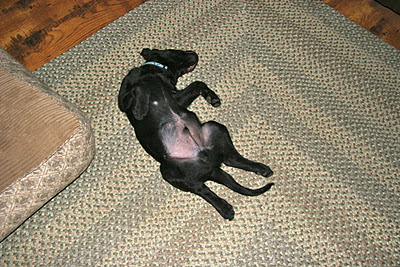Back when I was an Amateur, I really struggled at knowing when to step in and help my dog. I didn't know if I should handle for a bad line, help for a bad hunt or what to do?
We all know that training dogs is more an art then a science, so there are no black and white rules. Many different variables arise such as what the particular dog needs at that moment vs. keeping the standards of training high. But I will point out some generalizations of training on marking set-ups that I've learned over the past couple of years.
When to re-call:
We re-call for a poor initial line to the mark. We generally only re-call the dogs within the first 75 yards and more often then not it is less then that. A poor intial line does not mean the dog left great, but fell into factors on route.
Too many re-calls, especially ones at a distance, can really erode a dog's confidence and momentum. A re-call is as much mental pressure to a dog as a collar correction is physical pressure.
When to handle:
We handle dogs on marks when a dog loses their line to the mark due to losing the mark itself. This can be due to many factors such as suction of other marks, wind, terrain or just plain lack of focus of the dog. We try to use only enough handle to regain the mark and then allow the dog to resume and get the mark on their own. We don't handle all the way to the bird as if we were at a field trial. Training and trialing is always different.
Our personal belief is that we don't handle for having a bad mark i.e. backsiding a gun. Dogs trained to the All-Age level need to be independent thinkers and learn how to negotiate the tough tests they will see in an Open. We also believe that marking is as much learning where not to go as learning where to go. So if a dog is taking a wide line to a long retired and it looks to be on it's way to hooking the holding blind, we let the dog go. This teaches them to recover, to think, to have perserverance and feel confident in doing so. Many dogs are "area markers" at the distances we're dealing with in modern field trials, so it would unreasonable to expect pin-point marking at the All-Age level all of the time.
Don't forget that water is the #1 "factor" that we handle around. Our general rule is to correct to get in the water, but never to correct to get them out. This is always attrition and many a good water dog has been taught to hate the water due to poor corrections in and around the water.
When to have the gunner help:
We have gunner's help the dogs when they've reached the area of the fall and can't come up with the bird after an extended hunt. Some dogs at times, especially young dogs learning multiples, will "blow" out of a mark if they can't come up with it quickly. It is these types of scenarios where we have the gunner help to keep the dog in the area of the fall. We don't put them right on the bird, but get them back to establishing a hunt there. We don't believe in ever putting pressure on a dog in the area of the fall, as it can lead to dogs being nervous hunting around gunners, popping, "piggy" hunts at the area of the fall, severe blowing out, etc. Dogs need to be relaxed hunting in and around guns considering some of the tight tests we see these days.
When to do nothing:
There are times when a dog is putting on an extended hunt that is painful to watch. We let these dogs hunt, and then hunt some more. A tough short retired on a hen pheasant will need a dog that is willing to go in and really dig out the bird and feel comfortable doing so. Nothing teaches this more then the dog being rewarded with a bird after an extended hunt in training. As long as the dog isn't doing anything stupid...we let them hunt.
Before you do anything in training to assist your dog (re-call, handle or help), it is always helpful to ask yourself one question: Am I Teaching The Dog Anything? If the answer is no, or "I don't know", then best to sit back and let your dog figure it out.




